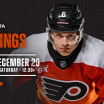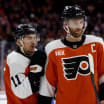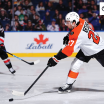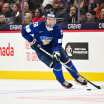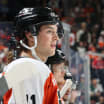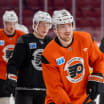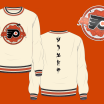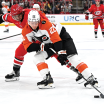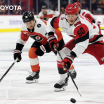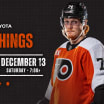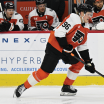Over the last 32 years, and certainly in the 2000s, the Pittsburgh Penguins have emerged the Philadelphia Flyers' bitterest rival. It wasn't always that way. Until the 1988-89 season, the battle was far too lopsided in the Flyers' favor to be called a true rivalry. At one juncture, most notably, the Penguins went nearly 15 full calendar years without collecting a single road win over the Flyers.
Rival in Focus: Pittsburgh Penguins

By
Bill Meltzer
philadelphiaflyers.com
The balance of power changed dramatically during the Mario Lemieux era. After a period of near dormancy again in the early 2000s, the rivalry exploded again after the arrival of Sidney Crosby (who still stands as the most hated/envied opposing player among a large segment of the Flyers' fan base).
From 1989 through 2017-18, playoff clashes between the Flyers and Penguins became frequent and intense. Philly prevailed in 1989, 1997, 2000 and 2012. The Penguins defeated the Flyers in 2008 (Eastern Conference Final), 2009 and 2018. Each time, the playoff clash heightened the enmity between the clubs and fanbases and there were carryovers into regular season meetings in subsequent years.
The Flyers and Penguins also played each other at the 2016-17 Stadium Series at Heinz Field in Pittsburgh (won by the Penguins) and a classic 2018-19 Stadium Series rematch at Lincoln Financial Field in Philadelphia (won in overtime by the Flyers after a dramatic comeback in the third period amid torrential rains).
Overall, the Flyers enter the 2020-21 season with an all-time 157-95-10 record in the regular season against the Penguins plus 30 ties (before the adoption of the shootout in 2005-06). At the Spectrum and Wells Fargo Center, the Flyers are 99-34-4 with eight ties. At the Igloo and PPG Paints Arena, the Flyers are 58-61-6 with 22 ties.
PENGUINS PUSH TO EXTEND CUP WINDOW
The Penguins are creeping up on the end of an era. The remaining pieces of their nucleus of the mid-2000s to the 2020s that delivered four Stanley Cup championships -- Crosby, Evgeni Malkin and Kris Letang -- are now creeping up on their mid-30s. Crosby turned 33 this past August. Malkin turned 34 at the end of July. Letang will turn 34 in April.
Make no mistake, however: All three players remain highly effective NHL players. Crosby is only a season removed from his most recent 100-point season and remains one of the top all-around impact players in the NHL. Malkin racked up 74 points last year despite being limited to 55 games played. Letang is still a prime offensive threat from the blueline (15 goals, 44 points).
Critics of Penguins general manager Jim Rutherford say that the Hockey Hall of Fame inductee, who will turn 72 next month, is creating a long-term bleak future by over-trading Draft pick assets annually to try to keep the team's Cup window open just a little longer. The Penguins have only selected once in the first round of the NHL Draft from 2016 to 2020 (right winger Samuel Poulin with the 21st overall pick of the 2019 Draft). In each of the last eight NHL Drafts, the Penguins have either made zero (four times) or only one (four times) selections within the first 50 picks of the Draft. Whenever the time comes that Crosby, Malkin and Letang are in full-fledged decline or retired, the bill is going to come due for all of the first-round and second-round assets that were dealt in all-out "win now" efforts.
That said, those efforts yielded a pair of additional Stanley Cup championships in back-to-back fashion as well as perennial contendership since then. Additionally, despite being behind the eight ball due to the dearth of top end picks, Penguins scouts have done a fine job over the last decade in identifying prospects beyond the first-round and early second-round range.
Jake Guentzel, a third-round pick in 2013, is in his prime at age 26, and had a 40-goal season (albeit with superstar talent around him) in 2018-19 and has produced three straight seasons of 20-plus goals. Twenty-three-year-old defenseman John Marino, recently signed to a long-term extension by the Penguins and being counted on as a vital piece of the puzzle in both the immediate and long-range future, was originally an Edmonton sixth-round pick in 2015 acquired by the Penguins for a 2021 sixth-round pick after three seasons at Harvard. Bryan Rust, 28, averaged just over a point per game last season (56 points in 55 games), and was originally a third-round pick by the Penguins back in 2010. Now the Penguins' No. 1 goalie, 25-year-old Tristan Jarry was a second-round Penguins pick in 2013.
Longtime Minnesota Wild forward Jason Zucker was acquired in trade by the Penguins last season in exchange for Alex Galchenyuk, a 2021 first-round pick and Calen Addison. Zucker, who will turn 30 on Jan. 16, produced 12 points (6g, 6a) in 15 regular season games with Pittsburgh and a pair of goals in the Penguins playoff qualification loss in four games to the underdog Montreal Canadiens in the Bubble in Toronto.
Are the aforementioned players "merely" strong complementary players who are sufficiently talented and hockey smart to gel in support of the superstars? Or are they the caliber of players who can carry a team themselves? The Penguins needn't find out as long as Crosby, Malkin and Letang are still going strong. Pittsburgh also still has good veteran depth even if the farm system overall is quite thin.
This offseason, the Penguins reacquired Kasperi Kapanen from the Maple Leafs at the cost of the 15th overall pick of the 2020 first round (Russian winger Rodion Amirov) along with David Warsofsky, Filip Hallander and veteran forward Evan Rodrigues (who subsequently returned to the Penguins on a one-year contract after the Maple Leafs turned him loose as an unrestricted free agent by not presenting a qualifying offer). Coming back along with the 24-year-old Kapanen (who had 13 goals and 36 assists last year after his first NHL 20-goal season the prior campaign) were 23-year-old defenseman Jesper Lindgren and 27-year-old left wing Pontus Åberg.
Pittsburgh also dealt former Stanley Cup-winning wunderkind goalie Matt Murray, who had fallen out of favor in Pittburgh, to the Ottawa Senators. The deal yielded 20-year-old center Jonathan Gruden (a USNTDP product who had a 30-goal, 66-point season in the OHL last year for the London Knights) plus a 2020 second-round pick (Finnish goalie Joel Blomqvist).
FLYERS VS. PENGUINS SEASON SERIES
Jan. 13: Pittsburgh Penguins @ Flyers
Jan. 15: Pittsburgh Penguins @ Flyers
Mar. 2: Flyers @ Pittsburgh Penguins
Mar. 4: Flyers @ Pittsburgh Penguins
Apr. 13: Flyers @ Pittsburgh Penguins
Apr. 15: Flyers @ Pittsburgh Penguins
May 3: Pittsburgh Penguins @ Flyers
May 4: Pittsburgh Penguins @ Flyers
RIVALRY HISTORY
Viewed in the totality of their respective team histories, the Pittsburgh Penguins have reached higher highs (five Stanley Cups to zero) and enjoyed greater success on the balance of the last 30 years than the Philadelphia Flyers. However, the Penguins have also had lower and lengthier lows including two long periods of the Penguins icing non-competitive teams, eras of financial insolvency (two bankruptcies) and periods of ownership instability, followed by a tumultuous history behind the construction of the team's current-day arena that, at one juncture, could have brought about the franchise's relocation to Kansas City.
That's in the past, however. The present-day Penguins are one of the NHL's marquee teams with a large fanbase and two future Hockey Hall of Fame players (Sidney Crosby and Evgeni Malkin) who may be on the back nine of their careers but remain superstar-caliber performers.
The Flyers and Penguins rivalry history can be divided into four eras: Pre-1989, 1990s to early 2000s, early-2000s to 2005-06, 2006-07 to present day.
Pre-1989
The Flyers shut out the Penguins, 1-0, in the first home game in Flyers' history (October 19, 1967). Doug Favell made 21 saves. At 2:59 of the third period, Bill Sutherland scored the game's only goal. Ultimately, the Flyers won the newly created Western Division and the Penguins missed the playoffs in their respective inaugural 1967-68 seasons.
Philadelphia and Pittsburgh never met in the playoffs before 1989 because the Penguins either missed the postseason entirely (13 times) or exited in the first round (six times) in 19 of their first 23 years of existence. In the other four seasons, Pittsburgh won one playoff round but lost in the second round. In the same span, the Flyers won two Stanley Cup championships (1973, 1974), reached the Stanley Cup Finals five times (1974, 1975. 1976, 1980, 1985, and 1987) and went as far as the Stanley Cup semifinals in 1973, 1977, 1978 and 1989.
For most of the Penguins first 23 seasons the team drifted somewhere in between being a middle-grade NHL club, a fringe playoff team and, for long stretches, a doormat buried at or near the bottom of the NHL. The selection of Mario Lemieux with the first pick of the 1984 NHL Draft marked the start of a change for fortunes.
In terms of head-to-head meetings between Pittsburgh and Philly in this era, it was no contest. From February 7, 1974, through February 2, 1989, the Flyers rattled off a 42-game home unbeaten streak (39-0 with three ties) at the Spectrum against Pittsburgh. This streak included the first four-plus years of Mario Lemieux's legendary career.
The NHL first introduced regular season overtime in 1983-84. The Flyers first-ever regular season OT win came at the expense of the Penguins at the Spectrum on Nov. 20, 1983. The winning goal was scored by Bob Clarke.
A few months before the Penguins drafted Lemieux, the Flyers pinned a 13-4 defeat on the Penguins at the Spectrum on March 22, 1984. Both Dave Poulin and Ilkka Sinisalo recorded hat tricks, while Tim Kerr scored twice. The offensive explosion remains tied for the Flyers' highest goal output in a single game.
Nearly five years later, the Penguins finally broke their futility streak in Philadelphia. However, in the spring of 1989, the Flyers struck back and won their first-ever playoff series against the Penguins. Backup goalie Ken Wregget subbed for injured starter Ron Hextall and the Flyers' prevailed, 4-1, at the Igloo in the seventh and deciding game.
1990 to 2000
The Flyers defeat of the Penguins in the 1989 Wales Conference Semifinal turned out to be the last hurrah together for many of players who formed the nucleus of the perennially contending Philadelphia clubs of the mid-1980s that twice reached the Stanley Cup Final.
Team captain Dave Poulin and five-time NHL All-Star Brian Propp would be gone within a year. Hpckey Hall of Fame defenseman Mark Howe's creaky back kept him out of the lineup for longer and longer stretches. Tim Kerr's body was also breaking down. Hextall had groin issues and contractual squabbles. A few were still going strong, such as Rick Tocchet, Pelle Eklund and Murray Craven, but the Flyers were now in decline.
Starting in 1989-90 and lasting through the 1994-94, the Flyers missed the playoffs five straight seasons. The Penguins, meanwhile, evolved into an elite team. Over the last 30 years, the Penguins have won the Stanley Cup five times (1990-91, 1991-92, 2008-09, 2015-16 and 2016-17) and made six trips overall to the Cup Final (including a six-game loss to the Detroit Red Wings in the 2008 Cup Final).
Offensively, they were led by Lemieux and a young Jaromir Jagr. Supporting those two generational talents, the Penguins stacked with top grade talent including 50-goal scoring power forward and veteran Hockey Hall of Fame offensive defenseman Paul Coffey. Irascible goaltender Tom Barrasso ended years of struggle between the pipes.
On March 4, 1991, the Penguins made a major trade with the Hartford Whalers, acquiring future Hall of Famer Ron Francis and ruthless shutdown defenseman Ulf Samuelsson in a six-player trade. The deal helped the late Bob Johnson's team go over the top, capturing their first Stanley Cup.
The next year, around the trade deadline, the Penguins made another blockbuster deal: this time with the rebuilding Flyers. Pittsburgh parted with young star right winger Mark Recchi, who already had a 100-point NHL season to his credit, in order to bring in power forward Rick Tocchet (the Flyers' captain until the trade), veteran defensive defenseman Kjell Samuelsson and backup goalie Wregget.
Pittsburgh went on to capture their second straight Stanley Cup. Meanwhile, Recchi came to Philadelphia as advertised. The next season, he set a franchise single-season record with 123 points and formed a dynamic duo with superstar rookie Eric Lindros.
Lindros made his NHL debut for the Flyers in Pittsburgh. On opening night of the 1992-93 season, the visiting Flyers played the two-time defending Cup champions to a 3-3 tie. Goals by Lemieux, Stevens and ex-Flyer Tocchet staked Pittsburgh to a 3-1 lead before Lindros keyed a third-period comeback by scoring his first career NHL goal on the first shift of the third period.
Recchi and Lindros were joined on their line by Brent Fedyk (called "the Crazy Eights", because Recchi wore uniform no. 8, Fedyk wore no. 18 and Lindros sported no. 88). In 1993-94, Calder Trophy finalist Mikael Renberg spent a significant part of the season on a line with Recchi and Lindros, setting a Flyers' rookie scoring record in the process.
Rivalry-wise, things hadn't really hit an apex. The Penguins were on top of the mountain now, and the Flyers were the team trying to climb the hill. There were tensions when the teams met -- for example pint-sized Flyers agitator Al Conroy once got Lemieux so angry that the superstar was tossed out of a 3-3 tie at the Spectrum -- but the rivalry hadn't hit a fever pitch yet.
Additionally, there were times when hockey hostilities took a back seat to the more important things in life. On March 2, 1993, Flyers fans gave Lemieux a standing ovation when he returned fto the Spectrum for his first game after undergoing successful radiation treatments for Hodgkin's Lymphoma. The Flyers won the game, 5-4.
From the lockout-shortened 1994-95 season until the 1999-2000 season, the Flyers and Penguins were both Stanley Cup contenders; the first time in the rivalry history that was the case simultaneously. The effect, of course, was to racket up the intensity of the rivalry.
The Flyers and Penguins faced off in the 1997 Eastern Conference Quarterfinal. The Flyers eliminated the Penguins in five games. Philly largely dominated this series. After the soon-to-retire Lemieux prevented a sweep on home ice in Game 4, a pair of Rod Brind'Amour shorthanded goals on the same penalty kill keyed a closeout victory for the Flyers in Game 5 at the brand new Wells Fargo Center (at the time known as the CoreStates Center).
In a respectful tribute to Lemieux's retirement, Flyers also stood, applauded and chanted "Mar-i-o! Mar-i-o!" during the last minute of play of Game 5. In the handshake line at the conclusion of the series, Lemieux delivered a personal message to Lindros, telling "the Big E" that the torch of the NHL's best player had been fully passed to him and it was Lindros' turn to run with it.
Lindros did just that until he started having concussion issues. The first one happened in a game in Pittsburgh on March 7, 1998, on a hit by longtime nemesis Darius Kasparaitis. The Flyers took particular exception after the fact to Kasparaitis and teammate Alexei Morozov seemingly laughing even after seeing Lindros had to be helped off the ice. Pittsburgh won the game, 6-4, in the front end of a home-and-home set.
The clubs rematched in Philadelphia the next night. It didn't take long to turn nasty as Flyers forward Colin Forbes dropped the gloves with Kasparitis at first site, while Chris Gratton fought Jiri Slegr. The Flyers prevailed in this game, 4-3.
The apex of this era's rivalry between the clubs came in the 2000 Eastern Conference Semifinal. After dropping Games 1 and 2 at home, the Flyers (playing without Lindros) went on to win four straight. Most famously, after the Flyers earned an overtime 4-3 win in the Igloo in Game 3, Game 4 went into five overtimes.
Brian Boucher stopped 57 of 58 shots while Ron Tugnutt stopped 70 of 71 until Keith Primeau's iconic top-shelf goal at 12:01 of the 5th OT. The 152:01 of hockey (60 regulation mins + 92:01 OT mins) played marked the third-longest game in NHL and the longest game since before World War II.
In Game 5, Andy Delmore became the Flyers first rookie defenseman to record a playoff hat trick. Philly closed out the series in Game 6.
Early 2000s to 2005-06
The Flyers remained near the top of the Eastern Conference in the early-to-mid 2000s, and came within a 2-1 loss to Tampa Bay in Game 7 of the 2004 Eastern Conference Final of returning to the Stanley Cup Final for the first time since 1997.
Conversely, this period was a painful time for the Penguins.By the end of the 1990s, the Penguins were once again beset with financial problems, and the team's on-ice fortunes sank with a bare-bones budget implemented.
Lemeiux returned to play after a three-year retirement and showed he could still be a dominant offensive force although the team itself was a shell of what it had been in the early-to-mid 1990s. More importantly for the team's long-range viability, Lemieux leveraged deferred compensation that he was owed by the Penguins and Pittsburgh restructured its ownership group with Lemieux as its controlling partner.
Jagr departed after the 2000-01 season via trade to the Washington Capitals. The team missed the playoffs four straight seasons and never reached as much as 70 points. They hit a nadir with 58 points.
A silver lining for Pittsburgh was the stockpiling of top-end first round picks. The Penguins got Ryan Whitney with the fifth overall pick in 2002, goalie Marc-Andre Fleury with the first overall pick in the legendary 2003 Draft, and Evgeni Malkin with the second overall selection in 2004 (Alex Ovechkin went first overall to Washington).
The 2004-05 lockout season and the implementation of a salary cap likely saved the Penguins and other small-market teams from folding. The Penguins also benefited from the NHL creating a lottery for the 2005 NHL Draft, and weighting it to favor the teams that were at the bottom of the standing in 2003-04. Pittsburgh won the lottery and selected projected generational player Crosby.
Pittsburgh was still a bottom-of-the-barrel team for one final year in 2005-06, despite Crosby immediately becoming a bonafide franchise player. He and the Flyers also quickly got on each other's bad side. The Flyers felt the rookie acted disrespectfully to veteran superstar Peter Forsberg. Crosby and the Penguins, meanwhile, took major umbrage at a high-sticking incident in which Philadelphia defenseman Derian Hatcher knocked out a couple of Crosby's teeth.
The Penguins got the second overall pick of the 2006 NHL Draft after their 58-point season. They used it to select two-way center Jordan Staal. Malkin and Staal joined the Penguins for the 2006-07 season (which coincided with the worst season in Flyers' franchise history, but which proved to be a once-off before a successful overhaul). The Penguins' fortunes took off with a bullet again.
On the ice, the Penguins were contenders again. Additionally, after an extremely long and difficult process that at one point had Lemieux and the organization considering relocation to Kansas City, the Penguins finally moved into a new area -- first called the Consol Energy Center, later renamed PPG Paints Arena -- to replace the Civic Arena (AKA the Igloo) starting in the 2010-11 season.
2006-07 to present
The Flyers rose immediately from the rubble of the disastrous 2006-07 season. This was keyed by the free agent signing of Danny Briere, the trade-and-sign acquisitions of Kimmo Timonen and Scott Hartnell from Nashville, trades for young defenseman Braydon Coburn and goalie Martin Biron.
Young stars began to emerge, too, as 2003 first-round picks Jeff Carter and Mike Richards started to come into their own. Holdover star Simon Gagne remained an impact player. He was later joined by 2006 first-round pick Claude Giroux.
The Flyers and the Penguins clashed in the 2008 Eastern Conference Final, one year after the Flyers had the worst record in the NHL and two years after Pittsburgh was at the bottom. Unfortunately for the Flyers, this wasn't much of a series, especially without the services of the Timonen (blood clot) and Coburn (facial injury) for most of the series. The Penguins prevailed easily in five games, with the Flyers winning only a Game 4 stand at home to avoid a sweep.
Pittsburgh played in the Cup Final for the first time since 1992 but lost to the Detroit Red Wings in six games. The next year, the Flyers and Penguins played again (this time in the first round). The series was much closer and harder-fought this time around, but the Penguins prevailed in six games, punctuated by a comeback win in Philly in the deciding game. The last game is remembered for a first period fight between Daniel Carcillo and Max Talbot (later a Flyer) the preceded the Pittsburgh comeback.
The Penguins won the 2008-09 Stanley Cup in a rematch with the Red Wings. The next year, the Flyers returned to the Cup Final for the first time since 1997 but fell two victories short of hockey's ultimate prize after losing Game 6 in overtime.
In the 2011 offseason, the Flyers made blockbuster trades that sent Carter to Columbus and Richards to Los Angeles and brought back a 2011 first-round pick (Sean Couturier), Jakub Voracek, Wayne Simmonds, rookie Brayden Schenn and a second-round pick flipped to Dallas during the latter part of the next season in exchange for physical, shot-blocking defenseman Nicklas Grossmann.
The 2011-12 season series and especially the first-round playoff series between Philly and Pittsburgh was arguably the wildest, most fight-filled, highest-scoring, chippiest and emotionally fraught in the rivalry's history. The most lasting image perhaps was that of Flyers head coach
Peter Laviolette standing on the bench, yelling at Pittsburgh assistant coach Tony Granato and head coach Dan Bylsma near the end of a nationally televised war of a game late in the regular season.
Entering the 2012 playoffs, the Penguins were nearly the universal selection among hockey pundits to win the Stanley Cup. The Flyers, however, weren't about to concede a thing. What ensued was a bizarre and ultra high-scoring six games (the teams combined for 56 goals, 30-26 in the Flyers' favor) with emotions at a fever pitch. A slew of fights as well as three head-hunting attempts by Pittsburgh's James Neal on a single shift punctuated Game 3 in particular.
No lead was safe in this series. In Game 1, the Flyers overcame a 3-0 deficit (and benefited from a Briere goal on a play that was allowed to stand despite being blatantly offside) to win in overtime on a Jakub Voracek goal. In Game 2, the Flyers again won in comeback fashion, with Giroux and rookie Couturier registering hat tricks. Philly took a 3-0 series lead after the brawl-filled Game 3 in Philadelphia.
Pittsburgh won the next two games to narrow the gap to three games to two. Before Game 6, Laviolette challenged his Flyers players by asking if each one was capable of bringing his A game for one afternoon. Giroux set the tone by landing a big hit on Crosby and scoring on the first shift of the afternoon. Philly went on to play a nearly flawless game, prevailing 4-1 to close out the series.
The fervor of the 2011-12 war had a carryover effect for several additional years, as sparks often flew whenever the teams met. Even players who rarely dropped the gloves, such as Voracek or Rob Scuderi, got involved in fisticuffs as the years progressed. Virtually every hamd a playoff-like feel.
However, it was not until 2018 that the Flyers and Penguins met again in the playoffs. Pittsburgh entered as the favorite and prevailed in six games. The Flyers wasted a hat trick from Couturier (who was playing through a sprained MCL) and a two-goal lead late in the second period in the final game.
In 2019, the Flyers avenged their Stadium Series loss at Heinz Field in Pittsburgh from two years earlier with a third period comeback and an overtime win on a Giroux goal at Lincoln Financial Field. During the 2019-20 season series, the Flyers went 1-1-1 against the Penguins.


